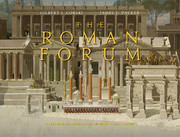21 - Conclusions
from Part III. - Conclusions
Published online by Cambridge University Press: 05 March 2015
Summary
The Augustan Forum
Augustus, as we have seen, continued Caesar’s projects and had, by the end of his reign (14 CE), totally rebuilt the Forum (Figs. 21.2, 21). Beginning with the Temple of Caesar (dedicated in 29 BCE), he ended by sponsoring Tiberius’ reconstruction of the Temple of Concord (dedicated in 6 CE). This work concluded centuries of piecemeal change: new buildings and monuments that related only incidentally to one another and to the architecture of the Forum as a whole. In contrast, the design, materials, and detailing of Augustus’ structures were the homogenous products of local craftsmen and numerous imported, highly experienced Hellenistic artisans. Enormous in scale, crafted from local materials and Italian and foreign marbles, superbly finished and detailed, they recalled, equaled, and even surpassed the structures in the great urban centers of the Greek East. Components of a single design, worked out gradually over three and a half decades, they all displayed four distinguishing characteristics: purpose, siting, design, and decoration.
Purpose
Augustus and his associates evidently considered the existing state of the Forum inviolable. That is, they generally did not demolish extant structures to erect substitutes. The Temple of Caesar, the new flanking arches, and Augustus’ enlargement of Caesar’s West Rostra marked the major exceptions to this rule (Figs. 0.3–4, 8.1–2). But for the temple, popular demand after Caesar’s assassination had already sanctioned a memorial column on the site, and the triumvirs who had preceded Augustus’ rise to power (and included Augustus himself) had decided on a new shrine. Indeed, for a youthful autocrat whose initial claim to power rested on the success and prestige of his adoptive father, deification of and a temple to that father were a political necessity. For the decorative arches that flanked the temple – the Parthian Arch on the south, the Arch of Lucius Caesar on the north (Figs. 0.3, 1.2) – major political and dynastic achievements, diplomatic success abroad (the Parthian Arch), and the promise of future dynastic stability at home (the Arch of Lucius Caesar) offered acceptable reasons. And, for Augustus’ enlargement of Caesar’s Rostra (Figs. 0.4, 1.3), a need for more space is probably the best explanation.
Information
- Type
- Chapter
- Information
- The Roman ForumA Reconstruction and Architectural Guide, pp. 335 - 362Publisher: Cambridge University PressPrint publication year: 2015
